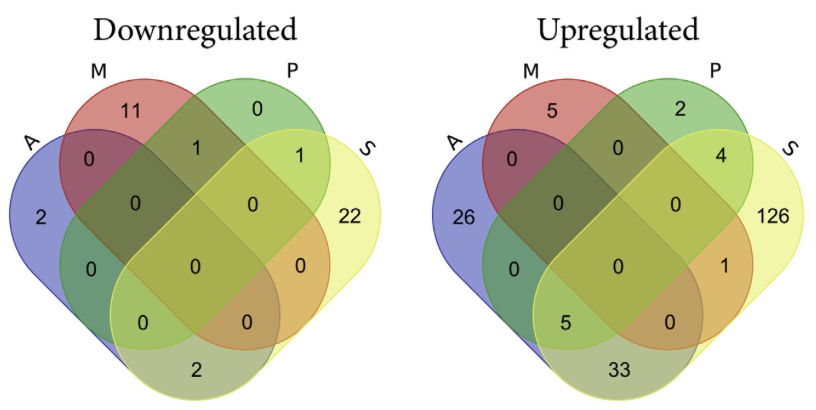Researching pathogenic parasites can be difficult due to strict laboratory requirements and the risk of infection. LEXSY can be used to investigate kinetoplastids in a safe and convenient way.
The eukaryotic expression system LEXSY has become popular with researchers of kinetoplastid parasites in recent years. Its classification as an S1 organism makes it a valuable and safe tool for parasite research. LEXSY has been successfully used to produce kinetoplastid antigens[1], investigate the interactions between parasite and host cells[2] and has been tested as a live vaccine against other pathogenic Leishmania species[3].
Furthermore, the LEXSY expression architecture can also be used in pathogenic Leishmania species and has e.g. been employed to study resistance development to antileishmanial drugs (Figure 1)[4].

Figure 1: Venn diagrams showing up- and downregulated genes in Leishmania mutants resistant to the antileishmanial agents amphotericin B (A), miltefosine (M), paromomycin (P) and antimonials (S). Data was collected from different Leishmania strains using LEXSY architecture. From Rastrojo et al. (2019)[4].

Need further information? Please check out the LEXSY section or contact Andreas by email at expression@jenabioscience.com !
[1] Ferrer et al. (2019) Production of Recombinant Trypanosoma cruzi Antigens in Leishmania tarentolae. Methods Mol. Biol. 1955:105.
[2] Geroldinger et al. (2019) Techniques to study phagocytosis and uptake of Leishmania tarentolae by J774 macrophages. Exp. Parasitol. 197:57.
[3] Nasiri et al. (2016) Immunogenicity and Efficacy of Live L. tarentolae Expressing KMP11-NTGP96-GFP Fusion as a Vaccine Candidate against Experimental Visceral Leishmaniasis Caused by L. infantum. Iran. J. Parasitol. 11:144.
[4] Rastrojo et al. (2018) Genomic and transcriptomic alterations in Leishmania donovani lines experimentally resistant to antileishmanial drugs. Int. J. Parasitol. Drugs Drug Resist. 8:246.